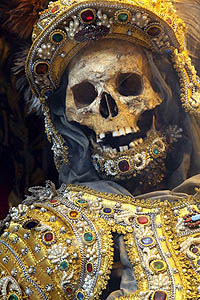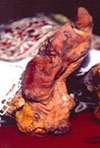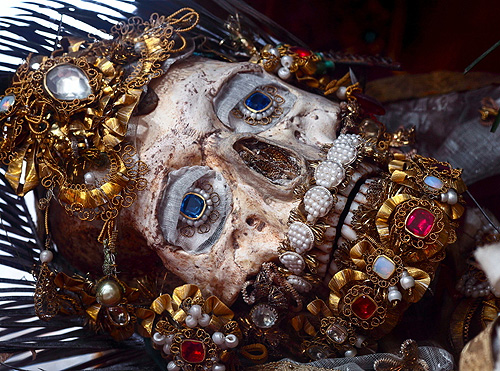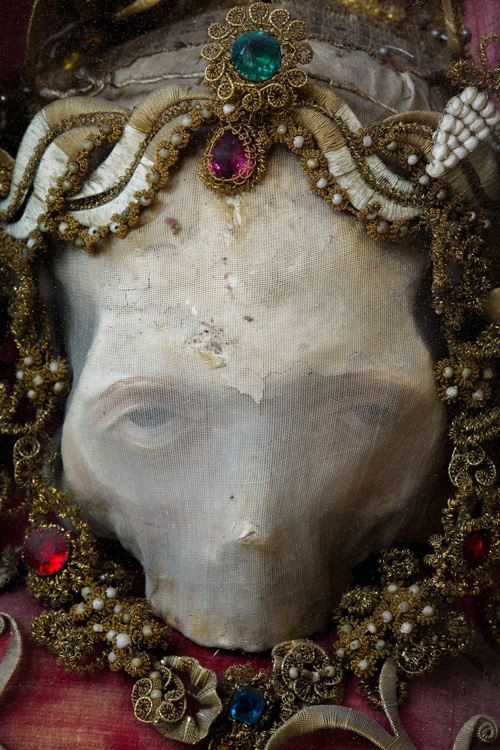| |
|
|
Christianity Is A Sick Death Cult
|
|
Christopher Hitchens
|
|
Christianity is often criticised as a death cult, with
its preoccupation with suffering, torture, death, relics
(human remains) and hell. Its most central doctrines concern
the torture and death of a man-god, and Roman Catholics
still purport to eat his (real) flesh and drink his (real)
blood. Its main emblem, the cross, worshipped like a holy
saint, is an instrument of torture and death.
In churches around Europe you can find the miraculously
preserved miracle-working relics of thousands of Christian
martyrs and other saints. At least that is what devout
Christians will tell you. According to many Christians,
saints' bodies do not decay like ordinary human bodies.
They miraculous stay fresh and sweet indefinitely. One
of the most curious aspects of this is that all of the
remains shown off as "perfectly preserved" are
at best mummified, and more often decomposed. Many of
these "perfectly preserved" remains are skeletons
with padded cloths, furnished with shoes, gloves and face
masks.
|
|
|
St Theodosius, Basilica of Waldsassen
|
 |
|
On Catholic websites you can easily find accounts of these
perfectly preserved remains, moving, smiling and requiring regular
attention for their hair and nails which continue to grow.
The Second Council of Nicaea in 787 decreed that every altar
should contain a relic, and this requirement remains part of
Church Law, in Catholic and Orthodox Churches.
Detractors say that these relics - often but not always the
remains of dead people - are one of the main manifestations
of necrophiliac practices, which appeal to a disturbingly large
number of Christians. Dressing up dead bodies in gold and jewels
and putting them on public display seems as best macabre, and
at worst confirmation that Christianity is a cult of death with
disturbing sexual overtones, evidenced by the strangely excited
states of some devotees. Other Christian devotees even pay the
dead-bodies money to do supernatural favours for them.
  One
of the more disturbing aspects of the cult of saints is the
dismemberment of bodies for the members to be preserved or sometimes
eaten by the devout. When Bishop Hugh of Lincoln chewed on a
bone of Mary Magdelene preserved at Fecamp he was challenged
by the guardians of the precious relic, and defended his action
by saying that if he could eat Christ's body [in the Catholic
mass] then he could certainly chew on the Magdalen's arm. One
of the more disturbing aspects of the cult of saints is the
dismemberment of bodies for the members to be preserved or sometimes
eaten by the devout. When Bishop Hugh of Lincoln chewed on a
bone of Mary Magdelene preserved at Fecamp he was challenged
by the guardians of the precious relic, and defended his action
by saying that if he could eat Christ's body [in the Catholic
mass] then he could certainly chew on the Magdalen's arm.
Devout and noble people often had their hearts removed after
death, and those who cut them out often noted that these hearts
had pictures engraved upon them, generally representing the
things most dear to them in life. Sadly none of these pictures
have survived on the perfectly preserved hearts of any of the
saints, for whom this miracle was claimed. (So our only surviving
reminder of the phenomenon is the often quoted claim of Bloody
Mary that the word "Calais" would be found written
on her heart after her death.
The question of whether relics have ever worked properly attested
miracles is covered at Miracles,
Revelation & Faith, but it is worth noting where many
relics come from.
|
According to the Catholic Church many came from the Christian
catacombs under Rome, and this is true as far as it goes.
The Roman catacombs had been abandoned as burial sites
and largely forgotten by the sixth century. They were
rediscovered in 1578 by vineyard workers. This looked
like a God-send as the Catholic Church was engaged in
the Counter-Reformation and keen to promote the cult of
relics. One of the areas of concern of the Council of
Trent was affirming the efficacy and belief in relics
against attacks by Protestant detractors. The bones in
the catacombs were a treasure trove. The remains in the
catacombs dated from the second to fifth centuries AD
so it was possible, for Churchmen to imagine the bones
as belonging to famous early Christian saints and martyrs.
They correctly saw the cache of bones as the perfect tool
to promote their power and wealth. The bones were removed,
sold to willing buyers, dressed in gold, silver and jewels,
and put on public display to attract the faithful.
|
|
|
Skull Cathedral in Otranto
|
|
|
|
What the Church is more reticent about is how we know whose
remains they are. There was no way of knowing if they belonged
to Christians or to pagans who had not been cremated (some but
not all pagans were cremated). To find out who the bones belonged
to Priests used psychic mediums, or acted as mediums themselves,
or even used the services of psychic popes. The practice continued
until the mid-19th century.
|
Churches in the German-speaking Alps, vied to obtain
the sanctified skeletons, in mass quantities. The Diocese
of Konstanz accumulated 120 of them in the 17th and 18th
centuries. The pose and decoration of the bones was left
to local churches, who used familiar methods to decide
on poses and the extent of decoration - they simply asked
the bones, again relying on psychic powers. Priests, nuns
and other mediums communed with the bones, and the bones
told them how they preferred to be posed and what they
would like to wear. At St Gallen Monastery a team of nuns,
prayed over the [second set of] remains of St Pancratius
until they were rewarded by details of his preferred articulation,
dress and jewels, though he neglected to mention that
he had died at the age of 14 and was not, as they thought,
a soldier. Sometimes the bones were more compliant. At
the Basilica at Waldsassen, according to local records,
the skeleton of St Maximus helpfully positioned itself.
For some reason, Catholic writers were reluctant to give
specifics about psychically communing with bones in the
catacombs, but SI Mahoney, a Catholic priest who left
the Church, wrote an account of the process. He said that
periodic trips were made to the catacombs, to augment
the supply of relics. No one knew the identity of the
skeletons, or even if the skeletons were those of Christians
- hence the need for psychic communications.
|
|
|
Bone Monstrance, The Sedlec Ossuary
(Czech: Kostnice v Sedlci) a Roman Catholic chapel,
beneath the Cemetery Church of All Saints, in Sedlec,
a suburb of Kutná Hora in the Czech Republic.
A monstrance or ostensorium is
a vessel used in Roman Catholic churches to display
the consecrated Eucharistic host, during Eucharistic
adoration or Benediction of the Blessed Sacrament.
|
|
|
|
Mahoney mentions that Pope Gregory XVI would descend into the
catacombs accompanied by priests. There he would invoke the
Holy Ghost, and read a prayer, "by which Divine assistance,
and directions from on high, is sought for the performance of
this… solemn duty. The Pope then casts his eyes around
the confused mass of mouldering skeletons, and, as the whim
may take him, calls this the body of saint such-a-one, another,
the body of 'Virgin some-other-one' - and so on, till he is
warned by his attendants that enough are now baptized…
to serve for the present occasion. The rotten bones are then
carefully collected, and, having been sprinkled with holy water,
are placed in a chest prepared for that purpose, and carried
in procession to the Vatican." [SI Mahoney, Six Years in
the Monasteries of Italy, and Two Years in the Islands of the
Mediterranean and in Asia Minor, New York, 1836, pp261-262.].
Such exercises were immensely profitable, as the holy relics
were then sold to the devout rich.
|
The psychic abilities of priests and popes were not always
reliable. They identified bones as belonging to Christians
they had heard of, but who had died and been buried elsewhere,
or whose miracle-working skeletons were already being
venerated, sometimes in several different places. Constantine
the Great, for example, was buried in Constantinople,
yet the bones of his second body were identified in the
catacombs and are now working their miracles in Rott-am-Inn,
a parochial church in Germany. The Church of St Nicholas
in Wil in Switzerland, possesses skeleton of the third-century
martyr St Pancratius, taken from the catacombs in the
17th century, even though the saint's relics were already
in the Basilica San Pancratio in Rome. The remains of
St Deodatus declared their identity to a papal secretary
in 1688, even though he had several other dead bodies
already being venerated and working miracles elsewhere
in Italy.
Perfectly preserved saintly bodies are becoming ever
less accessible to the public, and even to the faithful.
They can still be seen in a few traditionalist areas of
Europe, most notably at the Papal Basilica of Waldsassen
(Stiftsbasilika Waldsassen) - though it is notable that
such locations have ceased to be widely advertised.
|
|
|
Mummy at Santa Maria della Grazie,
Comiso, Sicily
By kind permission © Paul Koudounaris http://empiredelamort.com/
|
|
|
|
The Catholic Church is still keen on the cult of the dead,
celebrated at the beginning of November in pre-Christian times.
According to the current Catholic Enchiridion of Indulgences,
one can apply a plenary indulgence to a departed soul by the
"visitation of a cemetery" from November 1st to the
8th.:
13. Visit to a Cemetery (Coemeterii
visitatio)
An indulgence, applicable only to the
Souls in Purgatory, is granted to the faithful, who devoutly
visit a cemetery and pray, even if only mentally, for the
departed.
The indulgence is plenary each day
from the 1st to the 8th of November; on other days of the
year it is partial.
Most of this website is closely reasoned, but for the rest
of this page, the pictures can speak for themselves. Catholics
are encouraged to visit and venerate not just ordinary graves,
but dead bodies and dismembered body parts.
|
Saint Ambrose, Milan - not quite perfectly
preserved despite his great holiness
|
|
|
| |
|
The perfectly preserved remains of St
Francis Xavier in Goa in 2004
(The body is rumoured to be that of a Buddhist Monk dressed
up,
Francis Xavier's body having been buried as sea)
No DNA tests to establish the truth have been permitted
|
|
|
| |
|
The perfectly preserved remains of St
Francis Xavier in Goa
(His missing toes were bitten off by enthusiastic Christian
pilgrims)
|
|
|
| |
|
Chapel of Bones. Royal Church of St.
Francis. Portugal
|
|
|
| |
|
St Wenceslas at the Basilica in Stara
Bolesav, outside Prague
|
|
|
| |
|
Christians offer money to skulls to answer
their prayers
The Sedlec Ossuary beneath the Cemetery Church of All
Saints, in Sedlec, a suburb of Kutná Hora in the
Czech Republic.
By kind permission © Paul Koudounaris http://empiredelamort.com/
|
|
|
| |
|
Painted Skulls. Hallstatt Ossuary. Hallstatt,
Austria
|
|
|
| |
|
St Maximus, Basilica of Waldsassen
|
|
|
| |
|
|
Chiesa dei Morti, Urbino,
Italy
|
|
|
|
|
|
The body of
Pope Celestine V - his badly decomposed state
concealed by gloves and a wax mask
|
|
|
|
|
|
Pope Celestine V again -
note the wax mask and badly stuffed papal
glove.
|
|
|
|
|
|
St Clemens, Church of SS
Peter and Paul, Rott-am-Inn, Germany
|
|
|
|
|
|
| |
|
The conveniently labelled and miraculously
preserved skull of one of the many saints called
St Valentine
|
|
|
|
|
|
| |
|
The remains of John Neumann inside the
glass altar of St. Peter of the Apostle Church in Philadelphia,
USA
His skull is covered with a face mask. Evidently he is
regarded as a suitable playmate for young children.
|
|
|
| |
|
Monastery of Santa Maria della Concezione.
Rome, Italy
By kind permission © Paul Koudounaris http://empiredelamort.com/
|
|
|
| |
|
Another death cult - this is supposed
to be the Skull of St Mary Magdelen
kept at La Sainte Baume, Diocese of Frejus-Toulon, Southern
France.
It attracts thousands of pilgrims each year, and is sometimes
taken on world tours
|
|
|
| |
|
The Death mask of Martin Luther along
with casts of his hands. Lutherans and other protestants
do not recognise the veration of relics, so these gruesome
artefacts are kept in a museum, not a Church.
|
|
|
| |
|
The Ossuary of St. James' Church. Brno,
Czech Republic
|
|
|
| |
|
The body of Cardinal Schuster in the
Duomo, Milan
|
|
|
| |
| |
|
The perfectly preserved bodies of two
virgins
Chapel of the Virgins, Monastery of Santa Maria della
Pace, Palermo
|
|
|
| |
|
The perfectly preserved hand of St James,
kept in St. Peter's Catholic Church, Marlow, England
|
|
|
| |
|
These skeletons were recovered from the
Roman catacombs, and identified as Christian martyrs by
psychic Roman Catholic priests - and so might well not
even be the skeletons of Christians at all
Basilica of Waldsassen
|
|
|
| |
|
The perfectly preserved remains of Pope
Paul XXIII
His skull is fitted with a wax mask
|
|
|
| |
|
The Dead Lovers by Matthias Grünewald
(1470 - 1528)
|
|
|
| |
|
St Theodosius, Basilica of Waldsassen
|
|
|
| |
| |
|
Relics of St. Theodore of Tyro (known
as St. Theodore of Amasea in the West)
Brindisi Greek Orthodox Church dedicated to St. Nicholas
of Myra.
|
|
|
| |
|
The Czermna Skull Chapel.
It is situated in Klodzko County, near Kudowa Zdrój, in
the Lower Silesia, Poland.
|
|
|
| |
|
The Sedlec Ossuary (Czech: Kostnice v
Sedlci) a Roman Catholic chapel, beneath the Cemetery
Church of All Saints, in Sedlec, a suburb of Kutná
Hora in the Czech Republic.
|
|
|
| |
|
The Sedlec Ossuary (Czech: Kostnice v
Sedlci) a Roman Catholic chapel, beneath the Cemetery
Church of All Saints, in Sedlec, a suburb of Kutná
Hora in the Czech Republic.
|
|
|
| |
|
Schwarzenberg Coat-of-Arms. The Sedlec
Ossuary (Czech: Kostnice v Sedlci) a Roman Catholic chapel,
beneath the Cemetery Church of All Saints, in Sedlec,
a suburb of Kutná Hora in the Czech Republic.
|
|
|
| |
|
The Sedlec Ossuary (Czech: Kostnice v
Sedlci) a Roman Catholic chapel, beneath the Cemetery
Church of All Saints, in Sedlec, a suburb of Kutná
Hora in the Czech Republic.
|
|
|
| |
|
Ossuary chapel (Capela dos Ossos), Campo
Maior, Portugal
By kind permission © Paul Koudounaris http://empiredelamort.com/
|
|
|
| |
|
Chiesa di San Bernardino alle Ossa
|
|
|
| |
|
Ossuary (Osario), Custoza, Italy
By kind permission © Paul Koudounaris http://empiredelamort.com/
|
|
|
| |
|
The skull of Pope Pius X, covered with
a face mask
|
|
|
| |
|
Teresa of Avila was cut into pieces by
priests and bishops.
Here two nuns kiss her hand, preserved as a miracle-working
relic.
|
|
|
| |
|
The wax figure of St Victoria under the
St Margaret Mary Altar at St. Mary's Church in Kilkenny
City, Ireland
|
|
|
| |
|
Charnel house (Beinhaus = "bone-house"),
Leuk, Switzerland)
By kind permission © Paul Koudounaris http://empiredelamort.com/
|
|
|
| |
|
Family group in the catacombs,Santa
Maria della Pace, Palermo, Sicily
Readers with stronger stomachs than the webmaster can
look up the name "Rosalia Lombardo"
on Google for more about the death-cult at Santa Maria
della Pace
By kind permission © Paul Koudounaris http://empiredelamort.com
|
|
|
| |
|
Paris Catacombs
By kind permission © Paul Koudounaris http://empiredelamort.com
|
|
|
| |
|
Mummy Chiesa dei Morti (Church of Death),
Urbania, Italy
By kind permission © Paul Koudounaris http://empiredelamort.com
|
|
|
| |
|
The remains of Pope Pius IX (d 1878)
- acclaimed by the Church as being "almost perfectly
conserved"
|
|
|
| |
| |
|
Saint Valerius, Weyarn, Germany
By kind permission © Paul Koudounaris http://empiredelamort.com
|
|
|
| |
|
The body of the (fictitious) Saint Celia
(or Celia) was so well preserved that it has been replaced
by replicas. One is in plain marble, by Stefano Moderno
(1599) in the Church of St. Cecilia, Trastevere, Rome.
The other, a polychrome replica, is shown below.
|
|
|
| |
|
St Pancratius, Church of St Nicholas
in Wil, Switzerland.
you can see his perfectly preserved body within his specially
designed armour
|
|
|
| |
|
Bible illustration by Gustave Dore, The
Vision of the Valley of Dry Bones (Ezekiel 37:1-14)
|
|
|
| |
|
The Transi de René de Chalon,
ou Monument du cœur (Monument of the Heart), a sculpture
by Ligier Richier, carved around 1547. Today in the Church
of Saint-Étienne de Bar-le-Duc
|
|
|
| |
|
The perfectly preserved relics of Saint
Anthony of Padua,
displayed in the Relics Chapel of the Basilica in Padua,
Italy
|
|
|
| |
|
Relics in the Church of St. Anselmo,
Nin, Croatia. Less impressive relics are often kept in
gold and silver containers shaped like the part of the
saint's body they allegedly contain
|
|
|
| |
|
St Therese's relics on tour in Britain,
being venerated in Westminster Cathedral, London, in October
2009
|
|
|
| |
|
An example of Catholic "art"
|
|
|
| |
|
Chiesa dei Morti, Urbino, Italy
|
|
|
| |
|
Sacrifical and bleeding lambs are also
popular
|
|
|
| |
|
The perfectly preserved "Holy Right"
hand of King Stephen I, St. Stephen's Basilica in Budapest,
Hungary
|
|
|
| |
|
Saint Philip Neri, Chiesa Nuova, Rome
|
|
|
| |
|
One of the many miraculously preserved
heads of St. John the Baptist
This one is kept in the Cathedral Basilica of Our Lady
of Amiens
|
|
|
| |
|
Santa Muerte Pieta
|
|
|
| |
|
St. Valentin (Bad Schussenried, Germany)
|
|
|
| |
|
The Kiss of Death Statue at the Old Graveyard
of Poblenou in Barcelona
|
|
|
| |
|
Saint Vincent de Paul, Chapelle Saint-Vincent-de-Paul
(Paris, 6ème arrondissement)
|
|
|
| |
|
Mourning Jesus, or mourning a normal
family life?
|
|
|
| |
|
St. Valentinus (Waldsassen, Germany)
|
|
|
| |
|
St. Benedictus (Berg am Laim, Munich,
Germany)
|
|
|
| |
|
St. Deodatus (Rheinau, Swizterland)
|
|
|
| |
|
St. Albertus (Burgrain, Germany)
|
 |
| |
|
St. Valerius (Weyarn, Germany)
|
 |
| |
|
St. Felix (Gars am Inn, Germany)
|
|
|
| |
|
St. Vincentus (Stams, Austria)
|
 |
| |
|
St. Deodatus (Roggenburg, Germany)
|
 |
| |
|
St. Konstantious (Rorschach, Switzerland)
|
|
|
| |
|
St. Maximus (Bürglen, Switzerland)
|
|
|
| |
|
Familia de esqueletos (Family of Skeletons),
c. 1800,
José López Enguídanos (Valencia,
1760 – Madrid, 1812)
|
 |
| |
|
Perfectly preserved nun?
|
|
|
| |
| |
|
|
|
|
|
|
|
|
|
|
|
|
|
|
|
|
|
|
|
|
|
|
|
|
|
|
|
|
|
|
|
|
|
|
|
|
|
|
Buy the Book from Amazon.com
|
|
|
|
|
|
Buy the Book from Amazon.co.uk
|
|
|
| |
| |
| More Books |
|
|
|